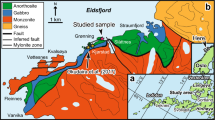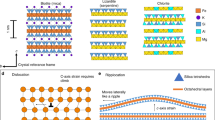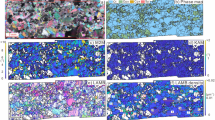Abstract
A prominent feature of a granulite-facies shear zone from the Hidaka Main Zone (Japan) is the folding of orthopyroxene (opx) porphyroclasts. Dislocation density estimated by transmission electron microscope (TEM) and chemical etching in homogeneously folded domains is too low to account for the amplitude of crystallographic bending, leading us to propose a model similar to “flexural slip” folding, where folded layers are micrometer-wide opx layers between thin planar clinopyroxene (cpx) exsolutions. Extension (compression) in the extrados (intrados) of the folded layer is accommodated by dislocations at the cpx–opx interfaces. Alternatively to distributed deformation, crystal bending also localizes in grain boundaries (GBs), mostly oriented close to the (001) plane and with various misorientation angles but misorientation axes consistently close to the b-axis. For misorientation up to a few degrees, GBs were imaged as tilt walls composed of regularly spaced (100)[001] dislocations. For misorientation angles of 7°, individual dislocations are no longer visible, but high-resolution TEM (HRTEM) observation showed the partial continuity of opx tetrahedral chains through the boundary. For 21° misorientation, the two adjacent crystals are completely separated by an incoherent boundary. In spite of these atomic-scale variations, all GBs share orientation and rotation axis, suggesting a continuous process of misorientation by symmetric incorporation of (100)[001] dislocations. In addition to the dominant GBs perpendicular to the (100) plane, boundaries at low angle with (100) planes are also present, incorporating dislocations with a component of Burgers vector along the a-axis. The two kinds of boundaries combine to delimit subgrains, which progressively rotate with respect to host grains around the b-axis, eventually leading to recrystallization of large porphyroclasts.















Similar content being viewed by others
References
Angel RJ, Hugh-Jones DA (1994) Equations of state and thermodynamic properties of enstatite pyroxenes. J Geophys Res 99(B10):19777–19783
Arita K, Mori M, Ogura K, Motoyoshi Y (1978) The metamorphic rocks and migmatites of the southern part of the Hidaka Metamorphic Belt. Assoc Geol Collabor Jpn Monogr 21:27–41
Boullier AM, Gueguen Y (1975) SP-Mylonites: Origin of some mylonites by superplastic flow. Contrib Mineral Petr 50:93–104
Buseck PR, Iijima S (1974) High-resolution electron microscopy of silicates. Am Mineral 59:1–21
Cameron M, Sueno S, Prewitt CT, Papike J (1973) High temperature crystal chemistry of acmite, diopside, hedenbergite, jadeite, spodumene and ureyite. Am Mineral 58:594–618
Coe RS, Kirby SH (1975) The orthoenstatite to clinoenstatite transformation by shearing and reversion by annealing: Mechanism and potential applications. Contr Mineral Petrol 52:29–55
Coe RS, Müller WF (1973) Crystallographic orientation of clinoenstatite produced by deformation of orthoenstatite. Science 180:64–66
Drury MR, Pennock G (2007) Subgrain rotation recrystallization in minerals. Mater Sci Forum 550:95–104
Duffy TS, Vaughan MT (1988) Elasticity of enstatite and its relationship to crystal structure. J Geophys Res 93(B1):383–391
Duyster J, Stöckhert B (2001) Grain boundary energies in olivine derived from natural microstructures. Contrib Mineral Petrol 140:567–576
Etheridge MA (1975) Deformation and recrystallisation of orthopyroxene from the Giles Complex, central Australia. Tectonophysics 25:87–114
Frisillo AL, Buljan ST (1972) Linear expansion coefficients of orthopyroxene to 1000°C. J Geophys Res 77:7115–7117
Guillopé M, Poirier JP (1979) Dynamic recrystallization during creep of single-crystalline halite: an experimental study. J Geophys Res 84:5557–5567
Heinemann S, Wirth R, Gottschalk M, Dresen G (2005) Synthetic [100] tilt grain boundaries in forsterite: 9.9° to 21.5°. Phys Chem Minerals 32:229–240
Herwegh M, Kunze K (2002) The influence of nano-scale second-phase particles on deformation of fine grained calcite mylonites. J Struct Geol 24:1463–1478
Hiraga T, Anderson IM, Kohlstedt DL (2004) Grain boundaries as reservoirs of incompatible elements in the Earth’s mantle. Nature 427:699–703
Hirth JP, Lothe J (1968) Theory of dislocations. McGraw-Hill, New York
Hirth G, Tullis J (1992) Dislocation creep regimes in quartz aggregates. J Struct Geol 14(2):145–159
Jolivet L, Miyashita S (1985) The Hidaka Shear Zone (Hokkaido, Japan): genesis during a right-lateral strike slip movement. Tectonics 4:289–302
Kanagawa K, Shimano H, Hiroi Y (2008) Mylonitic deformation of gabbro in the lower crust: A case study from the Pankenushi gabbro in the Hidaka metamorphic belt of central Hokkaido, Japan. J Struct Geol, doi:10.1016/j.jsg.2008.1005.1007
Kohlstedt DL, Van der Sande JB (1973) Transmission electron microscopy investigation of the defect microstructure of four natural orthopyroxenes. Contr Mineral Petrol 42:169–180
Kuhlmann-Wilsdorf D, Hansen N (1991) Geometrically necessary, incidental and subgrain boundaries. Scripta Metall Mater 25:1567
Levi AA, Smith DA, Wetzel JT (1991) Calculated structures for [001] symmetrical grain boundaries in silicon. J Appl Phys 69:2048–2056
Levien L, Prewitt CT (1981) High-pressure structural study of diopside. Am Mineral 66:315–323
McLaren AC, Etheridge MA (1976) A transmission electron microscope study of naturally deformed orthopyroxene. I. Slip mechanisms. Contr Mineral Petrol 57:163–177
Miyashita S, Maeda J (1978) The basic plutonic and metamorphic rocks from the northern Hidaka Metamorphic Belts, Hokkaido. Assoc Geol Collabor Jpn Monograph 21:43–60
Naze L, Doukhan N, Doukhan J-C, Latrous K (1987) A TEM study of lattice defects in naturally and experimentally deformed orthopyroxenes. Bull Mineral 110:497–512
Nicolas A, Poirier JP (1976) Crystalline plasticity and solid state flow in metamorphic rocks. Wiley, London, p 444
Osanai Y, Komatsu M, Owada M (1991) Metamorphism and granite genesis In the Hidaka Metamorphic Belt, Hokkaido, Japan. J Metamorp Geol 9(2):111–124
Passchier CW, Trouw RAJ (1996) Microtectonics. Springer, Berlin, p 289
Pennock G (2005) The development of subgrain misorientations with strain in dry synthetic NaCl measured using EBSD. J Struct Geol 27:2159–2170
Poirier JP (1995) Plastic rheology of crystals. In: Mineral Physics and crystallography, a handbook of physical constants. AGU, Bahrain, pp 237–247
Precigout J, Gueydan F, Gapais D, Garrido CJ, Essaifi A (2007) Strain localisation in the subcontinental mantle—a ductile alternative to the brittle mantle. Tectonophysics 445:318–336
Raimbourg H, Toyoshima T, Harima Y, Kimura G (2008) Grain size reduction mechanisms and rheological consequences in high-temperature gabbro mylonites of Hidaka, Hokkaido Earth Planet. Sci Lett 267:637–653
Raleigh CB, Kirby S, Carter NL, Ave Lallemant HG (1971) Slip and the clinoenstatite transformation as competing rate processes in enstatite. J Geophys Res 76(17):4011–4022
Ramsay JG (1967) Folding and fracturing of rocks. McGraw-Hill, New York, p 568
Read WT (1953) Dislocations in crystals. McGraw-Hill, New York
Salviulo G, Secco L, Antonini P, Piccirillo EM (1997) C2/c pyroxene from two alkaline sodic suites (Western Ross Embayment-Antarctica): crystal chemical characterization and its petrologic significance. Mineral Mag 61:423–439
Sato Y, Mizoguchi T, Oba F, Ikuhara Y, Yamamoto T (2005) Arrangement of multiple structural units in a [0001] Σ49 tilt grain boundary in ZnO. Phys Rev B 72, doi:10.1103/PhysRevB.1172.064109
Sellars CM (1978) Recrystallization of metals during hot deformation. Philos Trans R Soc Lond A 288(1350):147–158
Skemer P, Karato S-I (2007) Effects of solute segregation on the grain-growth kinetics of orthopyroxene with implications for the deformation of the upper mantle. Phys Earth Planet In 164:186–196
Smith DA (1996) On the general grain boundary. Interface Sci 4:11–27
Smyth JR (1973) An orthopyroxene structure up to 850°C. Am Mineral 58:636–648
Steuten JM, Van Roermund HLM (1989) An optical and electron microscopy study of defect microstructures in naturally deformed orthopyroxene. Tectonophysics 157:331–338
Sueno S, Cameron M, Prewitt CT (1976) Orthoferrosilite: high temperature crystal chemistry. Am Mineral 61:38–53
Timoshenko S, Goodier JN (1951) Theory of elasticity. McGraw-Hill, New York
Toyoshima T (1991) Tectonic evolution of the Hidaka metamorphic belt and its implication in late Cretaceous-Middle Tertiary Tectonics of Hokkaido, Japan. In: Science reports of Niigata University Series E, Geology and Mineralogy, No. 8, pp 1–107
Toyoshima T, Komatsu M, Shimura T (1994) Tectonic evolution of lower crustal rocks in an exposed magmatic arc section in the Hidaka metamorphic belt, Hokkaido, northern Japan. Island Arc 3:182–198
Toyoshima T, Komatsu M, Niizato T (2000) Granulite-grade gabbroic mylonites and crustal-scale decollement in a deep crust exposed in the Hidaka metamorphic belt. In: Geological Society of Japan Meeting, p 277
Tullis J, Yund RA (1985) Dynamic recrystallization of feldspar: a mechanism for ductile shear zone formation. Geology 13:238–241
Van Duysen JC, Doukhan N, Doukhan JC (1985) Transmission electron microscope study of dislocations in orthopyroxene (Mg, Fe)2Si206. Phys Chem Minerals 12:39–44
Wegner MW, Christie JM (1985) Chemical etching of amphiboles and pyroxenes. Phys Chem Minerals 12:86–89
White S (1977) Geological significance of recovery and recrystallization processes in quartz. Tectonophysics 39:143–170
Acknowledgments
Support for the project was provided by Grants-in-Aid for Scientific Research (KibanKenkyu 21540501) by MEXT (Ministry of Education, Culture, Sports, Science and Technology) of Japan. The manuscript benefited greatly from the very detailed comments by two anonymous reviewers.
Author information
Authors and Affiliations
Corresponding author
Additional information
Communicated by T. L. Grove.
Electronic supplementary material
Fig16
Supplementary material 1 HRTEM image of cpx exsolution and surrounding opx, with the incident beam parallel to the b-axis. Note the presence of localized strain (dark zones) within the lamellae and on its right boundary, which corresponds to (100)[001] dislocation (JPEG 577 kb)
Fig17
Supplementary material 2 Mixed origin of dislocations at cpx-opx interfaces. In the thermal mismatch model by Van Duysen, Doukhan and Doukhan (1985), dislocations of opposite sign accommodate at the cpx-opx interface the difference in plane density \( (d_{{001}}^{{cpx}} < d_{{001}}^{{opx}}) \), acquired during cooling. In the flexural slip model, dislocations of the same sign accommodate the lattice curvature. In contrast to thermal mismatch model, dislocation density needs not to be the same on upper and lower interface. The actual dislocation density is the sum of the two models, after recombination of dislocations of opposite sign on a given interface (JPEG 1628 kb)
Fig18
Supplementary material 3 Gradients in composition associated with recrystallization. (A) Optical microscope picture in reflected light, (B) sketch and (C) EPMA mapping of Ca distribution within a deformed opx porphyroclast. Recrystallized opx, either within the porphyroclast (“intra-opx deformed domain”) or on its rim (“small opx domain”) have a lower Ca content than the porphyroclast (“coherent opx domain”). Furthermore, within the recrystallized grains on the upper right of (A), grain boundaries are visible in (C) because of their low Ca concentration compared with the grains interiors. Within recrystallized zones, abundant cpx grains probably result from the depletion in Ca of the opx. Note that when considering a single boundary cutting across the opx, the Ca-depletion is visible only when the misorientation is very large (“GB1”), while no chemical heterogeneity is apparent for a lower misorientation (“GB2”) (JPEG 6148 kb)
Appendix
Appendix
We estimated the length of opx and cpx unit cell c parameter for T = 800°C and P = 0.7 GPa as:
where c 0 is the value for ambient P and T and αT and αP express the thermal dilatation and compressibility coefficients. For opx, \( \alpha_{\text{T}} \approx 0.16 \times 10^{ - 4} /^{ \circ } {\text{C}} \), irrespective of its composition (Frisillo and Buljan 1972; Sueno et al. 1976) and \( \alpha_{\text{P}} \approx - 3.5 \times 10^{ - 3} /{\text{GPa}} \) (Angel and Hugh-Jones 1994 for enstatite). For cpx, \( \alpha_{\text{T}} \approx 0.06 \times 10^{ - 4} /^{ \circ } {\text{C}} \) (Cameron et al. 1973 for either hedenbergite of diopside) and \( \alpha_{\text{P}} \approx - 2.8 \times 10^{ - 3} /{\text{GPa}} \) (Levien and Prewitt 1981 for diopside).
In other words, pressure-dependent variations are similar for cpx and opx, while thermal expansion of opx is much larger than in cpx. In contrast, unit cell parameter c 0 is consistently larger in cpx (Levien and Prewitt 1981; Salviulo, et al. 1997) than in opx (Angel and Hugh-Jones 1994; Smyth 1973; Sueno et al. 1976). To take into account the large compositional dependence of c 0, we considered compositions as close as possible to ours (Raimbourg et al. 2008): For opx, Smyth (1973) reported \( c_{0}^{\text{opx}} = 5.232\;{\text{\AA}} \), while for cpx, Salviulo et al. (1997) reported \( c_{0}^{\text{cpx1}} = 5.26\;{\text{\AA}} \) and \( c_{0}^{\text{cpx2}} = 5.28\;{\text{\AA}} \) for two samples of similar composition (VG3187 and VG3185Pc).
When considering the first value \( c_{0}^{\text{cpx1}} \), parameter c has roughly the same length in opx and in cpx for T = 800°C and P = 0.7 GPa, i.e., no mismatch dislocations are required. For the same P–T conditions, when considering the second value \( c_{0}^{\text{cpx2}} \), \( c^{\text{cpx2}} \) is larger than \( c^{\text{opx}} \) by ~0.2%, which implies dislocations spaced by 250 nm.
These calculations tend to show that \( c^{\text{cpx}} > c^{\text{opx}} \) at high P and T, requiring emplacement of mismatch dislocations along the interface. Our own HRTEM observations of the polarity of regularly spaced dislocations along the interface of a lamellae in a domain devoid of bending show similarly that \( c^{\text{cpx}} > c^{\text{opx}} \). On the other hand, the large uncertainties in unit cell parameter at ambient conditions, of the order of the pressure- and temperature-dependent variations, preclude to precisely assess the density of such mismatch dislocations and we retain therefore only the possible magnitude of dislocation spacing, as of the order of a few hundreds of nanometers.
Rights and permissions
About this article
Cite this article
Raimbourg, H., Kogure, T. & Toyoshima, T. Crystal bending, subgrain boundary development, and recrystallization in orthopyroxene during granulite-facies deformation. Contrib Mineral Petrol 162, 1093–1111 (2011). https://doi.org/10.1007/s00410-011-0642-3
Received:
Accepted:
Published:
Issue Date:
DOI: https://doi.org/10.1007/s00410-011-0642-3




